
A fence is a structure that encloses an area, typically outdoors, and is usually constructed from posts that are connected by boards, wire, rails or netting. A fence differs from a wall in not having a solid foundation along its whole length.
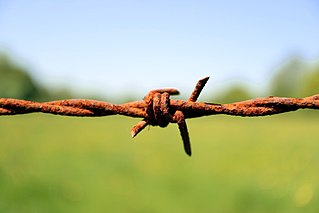
Barbed wire, also known as barb wire, is a type of steel fencing wire constructed with sharp edges or points arranged at intervals along the strands. Its primary use is the construction of inexpensive fences, and it is also used as a security measure atop walls surrounding property. As a wire obstacle, it is a major feature of the fortifications in trench warfare.
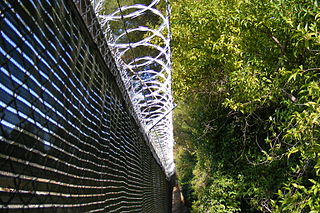
Barbed tape or razor wire is a mesh of metal strips with sharp edges whose purpose is to prevent trespassing by humans. The term "razor wire", through long usage, has generally been used to describe barbed tape products. Razor wire is much sharper than the standard barbed wire; it is named after its appearance but is not razor sharp. The points are very sharp and made to rip and snag clothing and flesh.

A paper clip is a tool used to hold sheets of paper together, usually made of steel wire bent to a looped shape. Most paper clips are variations of the Gem type introduced in the 1890s or earlier, characterized by the one and a half loops made by the wire. Common to paper clips proper is their utilization of torsion and elasticity in the wire, and friction between wire and paper. When a moderate number of sheets are inserted between the two "tongues" of the clip, the tongues will be forced apart and cause torsion in the bend of the wire to grip the sheets together. They are usually used to bind papers together for productivity and portability.

In agriculture, fences are used to keep animals in or out of an area. They can be made from a wide variety of materials, depending on terrain, location and animals to be confined. Most agricultural fencing averages about 4 feet (1.2 m) high, and in some places, the height and construction of fences designed to hold livestock is mandated by law.

Chicken wire, or poultry netting, is a mesh of wire commonly used to fence in fowl, such as chickens, in a run or coop. It is made of thin, flexible, galvanized steel wire with hexagonal gaps. Available in 1⁄2 inch, 1 inch diameter, and 2 inch, chicken wire is available in various gauges—usually 19 gauge to 22 gauge. Chicken wire is occasionally used to build inexpensive pens for small animals though the thinness and zinc content of galvanized wire may be inappropriate for animals prone to gnawing and will not keep out predators.

An electric fence is a barrier that uses electric shocks to deter people and other animals from crossing a boundary. The voltage of the shock may have effects ranging from discomfort to death. Most electric fences are used for agricultural fencing and other forms of non-human animal control, although they are also used to protect high-security areas such as military installations or prisons, where potentially-lethal voltages may be used. Virtual electric fences for livestock using GPS technology have also been developed.

There are many aspects to horse management. Horses, ponies, mules, donkeys and other domesticated equids require attention from humans for optimal health and long life.
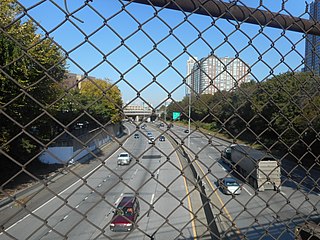
A chain-link fence is a type of woven fence usually made from galvanized or linear low-density polyethylene-coated steel wire. The wires run vertically and are bent into a zigzag pattern so that each "zig" hooks with the wire immediately on one side and each "zag" with the wire immediately on the other. This forms the characteristic diamond pattern seen in this type of fence.

A pitch or a sports ground is an outdoor playing area for various sports. The term pitch is most commonly used in British English, while the comparable term in Australian, American and Canadian English is playing field or sports field.
The clipped tag is a radio frequency identification (RFID) tag designed to enhance consumer privacy. RFID is an identification technology in which information stored in semiconductor chips contained in RFID tags is communicated by means of radio waves to RFID readers. The most simple passive RFID tags do not have batteries or transmitters. They get their energy from the field of the reader. They transfer their information to the reader by modulating the signal that is reflected back to the reader by the tag. Because tags depend on the reader for power their range is limited, typically up to 10 meters (33 ft) for UHF RFID tags.

A chain is a serial assembly of connected pieces, called links, typically made of metal, with an overall character similar to that of a rope in that it is flexible and curved in compression but linear, rigid, and load-bearing in tension. A chain may consist of two or more links. Chains can be classified by their design, which can be dictated by their use:
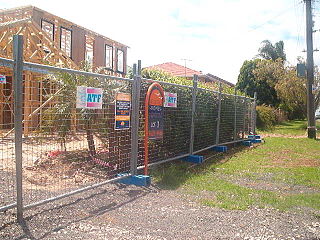
Temporary fencing is a free standing, self-supporting fence panel. The panels are held together with couplers that interlock panels together making it portable and flexible for a wide range of applications. A common type of temporary fencing is Heras fencing.

A steel fence post, also called a T-post, a Y-post, or variants on star post, is a type of fence post or picket. They are made of steel and are sometimes manufactured using durable rail steel. They can be used to support various types of wire or wire mesh. The end view of the post creates an obvious T, Y, or other shape. The posts are driven into the ground with a manual or pneumatic post pounder. All along the post, along the spine, there are studs or nubs that prevent the barbed wire or mesh from sliding up or down the post. They are generally designated as 1.01, 1.25 or 1.33, referring to the weight in pounds per lineal foot. They are commonly painted with a white tip on top; white improves the visibility of the fence line. When driving the post with a post pounder the white top paint is a visual means to ensure the user doesn’t raise the pounder too high while pounding. Raising the pounder too high allows it to lean towards the user and could lean to striking them in the head.

A pest-exclusion fence is a barrier that is built to exclude certain types of animal pests from an enclosure. This may be to protect plants in horticulture, preserve grassland for grazing animals, separate species carrying diseases from livestock, prevent troublesome species entering roadways, or to protect endemic species in nature reserves. These fences are not necessarily traditional wire barriers, but may also include barriers of sound, or smell.
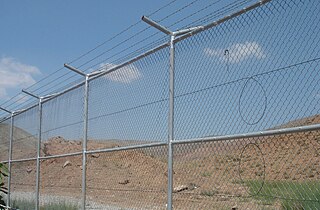
Demarcation of a perimeter, when the protection of assets, personnel or buildings is required, is normally affected by the building of a perimeter fence system. The level of protection offered varies according to the threat level to the perimeter. Different types of perimeter fencing include:

A silt fence, sometimes (misleadingly) called a "filter fence," is a temporary sediment control device used on construction sites to protect water quality in nearby streams, rivers, lakes and seas from sediment in stormwater runoff. Silt fences are widely used on construction sites in North America and elsewhere, due to their low cost and simple design. However, their effectiveness in controlling sediment can be limited, due to problems with poor installation, proper placement, and/or inadequate maintenance.

A synthetic fence, plastic fence or (when made of vinyl) vinyl or PVC fence is a fence made using synthetic plastics, such as vinyl (PVC), polypropylene, nylon, polythene (polyethylene) ASA, or from various recycled plastics. Composites of two or more plastics can also be used to increase strength and UV stability of a fence. Synthetic fencing was first introduced to the agricultural industry in the 1980s as low-cost, durable horse fencing. Now, synthetic fencing is used for agricultural fencing, horse race track running rail, and residential use. Synthetic fencing is generally available preformed, in a wide variety of styles. It tends to be easy to clean, resists weathering and has low maintenance requirements. However, it also can be more expensive than comparable materials, and cheaper products can be less sturdy than more traditional fence materials. Some types may become brittle, faded or degrade in quality after long exposure to extreme hot or cold conditions. Recently, titanium dioxide (TiO2) and other UV stabilisers have proven to be a beneficial additives in the manufacturing process of vinyl. This has greatly improved the durability of vinyl by providing essential UV protection from the sun's harmful rays, preventing premature ageing and cracking of the product, making it more durable than other materials such as wood.
Weldedwire mesh fence is a steel fence consisting of wire strands electrically welded together to form a high strength mesh. The fencing is available in two formats: rolled mesh and rigid mesh. Over the last 30 years rigid mesh fencing has become the system of choice for demarcation across the UK, Europe and Australia.
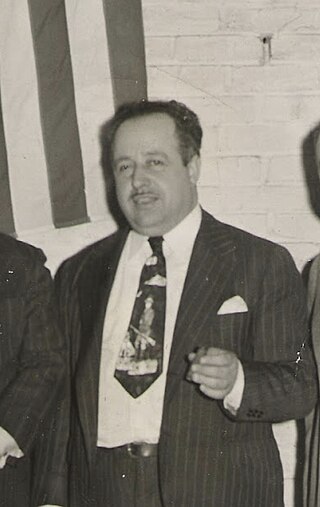
Francesco "Frank" John Mafera, Sr. was an American businessman and inventor notable for patenting the first method for weaving chain-link fencing. In 1930, Mafera filed an application for a "method of forming wire fence fabric", which was approved in 1931. Mafera's brother already owned a chain-link fence company in Medford, Massachusetts, and Mafera's 1931 patent was one of the several advancements made by the Maferas in the development of chain-link fencing.

















